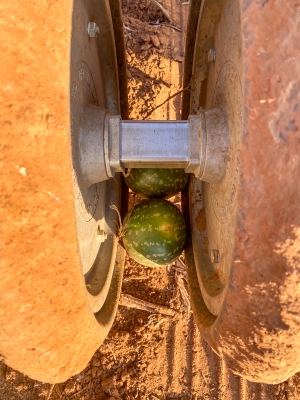GRDC guides can help growers identify weeds
Date: 09 Nov 2020

Late-season rain has resulted in some harvest headaches for Western Australian grain growers, including the emergence of weeds.
However, recently published Grains Research and Development Corporation (GRDC) resources are available to help growers to correctly identify which weeds are present, to help guide their management decisions.
The Identifying Western Australian summer weeds manual and Common Weeds of Grain Cropping: The Ute Guide include clear descriptions and images of weed species, through a range of growth stages, and can be used by grain growers to identify emerging weeds.
Andrew Storrie, of AGRONOMO, who authored the summer weeds manual, said accurate identification of weeds was critical to ensure that the correct management options were employed to achieve effective control.
“Misidentification can lead to ineffective and costly control practices. If you cannot identify a weed using the GRDC weed manuals, I encourage growers not to guess but to instead ask their agronomist to assist with identification,” he said.
Mr Storrie says it is important to ‘speak the same language’ when referring to weed species, as the use of common names could sometimes lead to incorrect identification and management.
“For example, summer weed surveys I have conducted on behalf of GRDC have highlighted that in some areas of WA’s grainbelt, Citrullus lanatus (Afghan melon) and Cucumis myriocarpus (prickly paddy melon) are often are confused with each other.
“This has implications as prickly paddy melonis more difficult to control than Afghan melon.”
Mr Storrie encouraged growers who could not control weeds during the harvest period to take steps to manage them before going on summer holidays.
“Every grower understands that large weeds are harder to control and that, in summer, weeds grow faster and can set seed in weeks,” he said.
“If spraying weeds in paddocks with crops – which might happen with later-harvested paddocks – growers need to adhere to withholding periods for herbicides, with more information available in the GRDC Pre-harvest herbicide use fact sheet.”
Mr Storrie said that in some areas, melon species had germinated within a few days of the recent rainfall, and he expected fleabane species and common sowthistle (Sonchus oleraceus) would also emerge given the timing of the rain.
“I also expect caltrop (Tribulus terrestris L.) to germinate – this weed is a significant issue for many growers, particularly due to the short period of time between it germinating and setting viable seed.
“More information about this weed and its management is available in a recent WeedSmart podcast that I was interviewed in.”
Growers are also encouraged to be on the look-out for some winter weeds that might be emerging after late spring rains.
Mr Storrie is conducting a two-year summer weed survey of WA cropping districts on behalf of the GRDC.
GRDC Crop Protection Manager – West, Georgia Megirian, said the survey, which started last summer, would increase understanding of the current composition of summer weed species in the western region and help inform future research, development and extension.
“Controlling summer weeds has a positive impact on soil moisture and nutrient levels which has a direct impact on subsequent grain crop yields and profitability,” Ms Megirian said.
“The summer weed surveys are being conducted in 197 paddocks ranging from Binnu in the WA’s northern grainbelt to Porongurup in the south, and Beaumont in the south-east.”
Ms Megirian said the earlier surveys conducted between January and April 2020 found that:
- Broadleaf weed species out-numbered grass weeds by 3.5 to one
- Fleabane was expanding its range north, while button grass was moving south
- The most widespread and common broadleaved weeds were mintweed, prickly paddy melon, Afghan melon, caltrop, wild radish, mallow and wild turnip
- The most common summer grass weeds were stink grass, button grass and small burrgrass.
More information on weed management is available from the GRDC-supported WeedSmart initiative. WeedSmart is the ‘single industry’ multi-channel platform for information on combating cropping weeds and herbicide resistance in Australia.
The Identifying Western Australian summer weeds manual and Common Weeds of Grain Cropping: The Ute Guide are available in hard copy and online (limited hard copies are available of the WA manual).
For copies of both titles: Free phone 1800 11 00 44 or email ground-cover-direct@canprint.com.au (postage and handing charge applies).
Contact details
For interviews
Andrew Storrie, AGRONOMO
0428 423 577
andrew@agronomo.com.au
Georgia Megirian, GRDC
0439 575 900
georgia.megirian@grdc.com.au
Contact
media@grdc.com.au GRDC
0427 189 827
media@grdc.com.au
GRDC Project Code: ARN1911-001WSX,
Was this page helpful?
YOUR FEEDBACK
